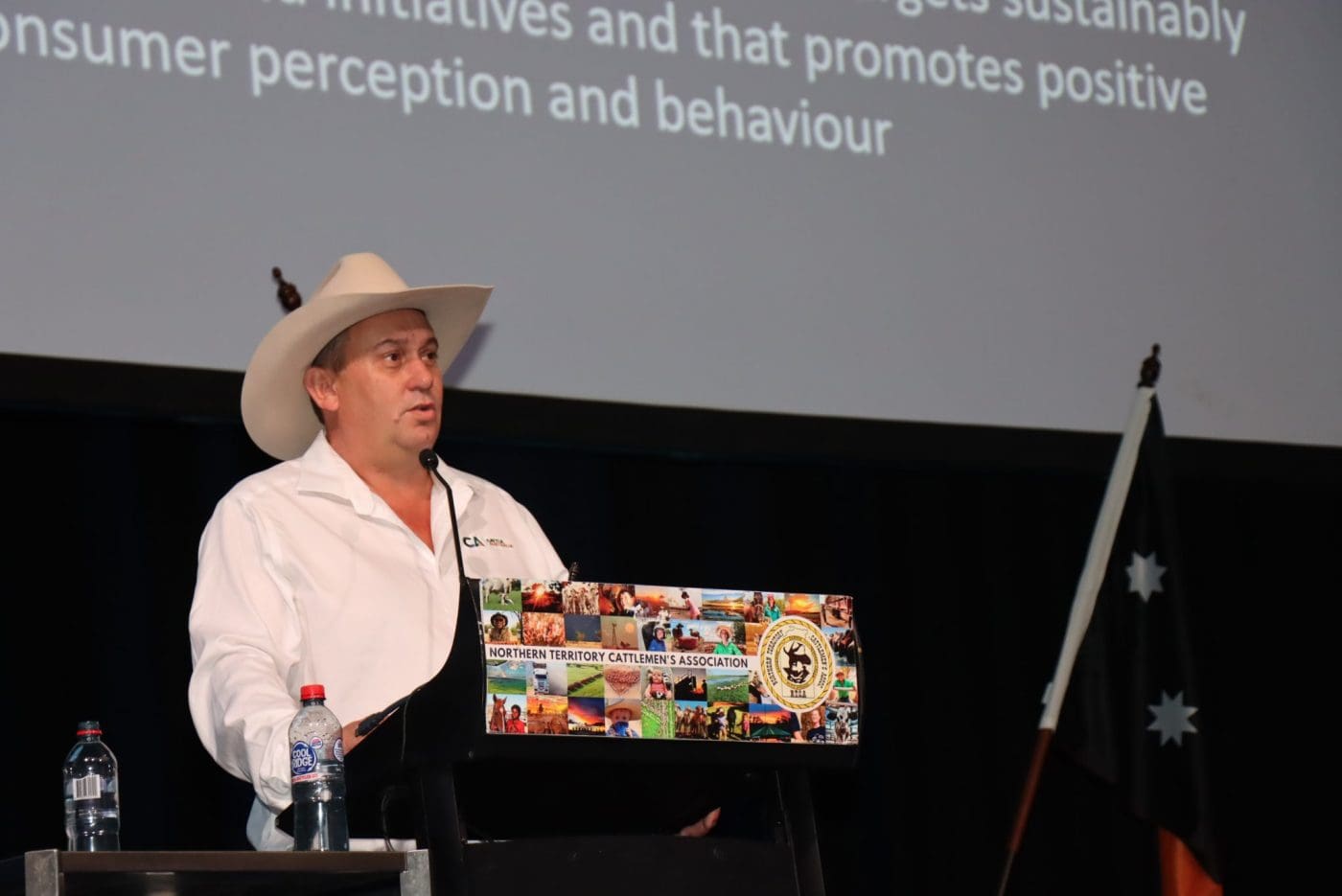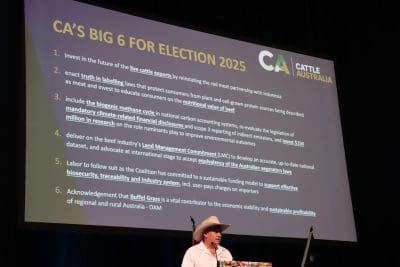
NTCA president Garry Edwards addressing the 2025 Nothern Territory Cattlemen’s Conference in Darwin last Friday.
Cattle Australia has revealed it will initiate a review of the Cattle Transaction Levy this year, with President Garry Edwards telling the Northern Territory Cattlemen’s Association conference in Darwin the current methodology significantly underfunds important parts of the industry.
In a straight-shooting address Mr Edwards also set his sights on several other issues, including:
> Rejecting United States cattle industry claims Australia is unfairly blocking its beef exports;
> Declaring Buffel Grass should be presented an Order of Australia Medal;
> Branding Federal Government moves to block the Beef Herd Carbon Methodology as “absolute insanity” and
> Calling on the Federal Government to enact recommended truth in labelling legislation to prevent people from being able to “call a bunch of sodium and salt beef”.
‘US has one simple requirement to meet’
In comments to a US Government trade inquiry that that caught the attention of the Australian beef industry last week, the US National Cattlemen’s Beef Association said that for 20 years Australia had used a “myriad of sanitary concerns and endless bureaucratic red tape” to unjustifiably delay the approval of US beef to the Australian market.
However Mr Edwards said publicity surrounding the issue had been shrouded in distortion and confusion, because the US “has had access to the Australian beef industry for over 20 years”.
“Just so we’re clear today, the US has absolute access to our market, providing they meet the obligations that we have to meet to go to theirs, which is around country of origin labelling and traceability of their supply chain,” he said.
“They’ve been unwilling to commit to identifying the Canadian cattle, to identifying the Mexican cattle, to identifying other cattle that come from other countries to Mexico to make their way to the US and we have rightfully stood our ground in regards to protecting our industry to make sure we don’t have issues that we don’t know about come through that supply chain.
“Now, I do talk to a lot of people that don’t have that understanding, and really that’s on us as an industry representative body to make sure we understand that.
“But this is not a new thing. The reasonable thing that we’re after is that you have to do absolutely everything that we have to do to go into your market.
“I don’t think that’s an unreasonable request. We expect to have our food supply protected as they have theirs protected.
“So this is something that’s an ongoing matter and something that will get lots of distorted publicity about, because it’s one of the most misreported components that happens in our industry, and it really is a challenge to get the right story out there and keep people informed.”
Time for a levy review
Mr Edwards also told the audience of northern cattle producers that Cattle Australia will initiate a levy review aimed at securing a sustainable levy funding structure for the industry.
By way of background, the Cattle Transaction Levy was increased from $3.50 per head to $5 per head in 2006 and was last reviewed in 2009, when levy payers voted to maintain the rate at $5 per head. Proceeds from the annual levy go toward funding marketing, research, animal health, and the National Residue Survey on behalf of the Australian beef cattle industry.
“The levy system we’ve had in place for some time has worked, but it’s very rigid, and we’ve got significant parts of our industry that are underfunded based off that current methodology,” Mr Edwards said.
“So we will be looking at what is a sustainable modernisation of that moving forward.
“And we’ll ensure that the industry’s interests are achieved through an equitable based levy funding structure.
“We need to make sure that the balance between market promotion, research, what we do in residues, what we do in animal health, what we do in representation of policy and advocacy matters are appropriately funded.”
Buffel Grass OAM
Mr Edwards also took aim at campaigns by environmental groups to declare buffel grass a weed of national significance, which he said ignored the vital contribution the grass had made to the economic viability and sustainable profitability of regional and rural Australia.
“In fact, I think we should nominate buffel grass for an Order of Australia medal for its sustainable long-term enhancement and efforts in contributing the profitability of regional Australia,” he said, sparking applause and cheers from the conference audience.
“Now we might get attention if we start nominating buffel grass for awards like that, and we can just continue to do that to highlight the stupidity of the situation that we’re dealing with, because that’s what our antagonists are prepared to do.
“And until we’re prepared to do that and just walk in and say, ‘No, that’s not good enough. That is bullsh*t.
“If you want to compare buffel grass to the same environmental impact as lantana or blackberries, and all of the various other things that are actual weeds that sit on it, as against something that produces millions of kilos of beef to support the provision of very high-quality proteins to our domestic and international markets, I’m just not sure whether the debate’s lost the rationality here.”
Blocking Beef Carbon Herd Methodology ‘absolute insanity’
He also described as “absolute insanity” the steps the Federal Government took last year to block the Beef Herd Carbon Methodology.
“It’s left the only industry that can have a positive impact on the whole carbon methane cycle without a methodology of how we can legitimately participate in it.
“I’m just not sure what level of insanity it takes to explain that to people, because there is no other industry where you can impact carbon in the atmosphere or anywhere on our entire process or globe that we live in, but agriculture. Everything else is a contributor to it.
“The only one that actually has a chance of removing it and dealing with its cyclical nature is agriculture.”
2025 Election priorities
 Mr Edwards also identified a list of key priorities Cattle Australia has targeted for the Federal election including:
Mr Edwards also identified a list of key priorities Cattle Australia has targeted for the Federal election including:
> Investment in the future of the live cattle trade and reinstating the Red Meat Livestock partnership with Indonesia;
> Enacting truth in labelling “so no more do you get to call a bunch of sodium and salt beef”;
> The inclusion of biogenic methane cycle in the national carbon accounting;
> Deliver on the beef industry’s land management commitment and getting equivalency on vegetation laws around the world in order to have fair and equitable access to markets;
> A sustainable funding model to support effective biosecurity, traceability and our industry systems, including the user pays system.
Confusion around cattle industry’s critical advocacy role
Mr Edwards also warned that many Australian cattle producers incorrectly assume that Meat & Livestock Australia can fill a critical advocacy role for the industry, despite MLA being prohibited from advocacy by its statutory funding agreement.
He said collective advocacy through Cattle Australia was essential to drive change, with infighting only helping politicians to do nothing on critical policy decisions.
As a multi-billion-dollar industry with 52,000 plus levy payers and supporting 430,000 jobs the beef cattle sector was the largest single economic contributor of Australian primary industry outside mining.
“It’s about time we understood that we are the 50,000-pound gorilla in the room that just hasn’t been woken up.
“Because if we all do collaborate, there are pretty amazing things we can do. “

It is absurd that Buffel Grass is being vilified. It is the backbone of one of the biggest primary industries in Australia and one of the biggest manufacturing industry in Australia, beef processing.
It helps prevent erosion and increases carbon sequestration.
You only have to witness the impact Indian Couch is having on productive Buffel, Rhodes and Panic country in Central and Southern Queensland
It has greatly assisted in turning regions of Qld and the NT into some of the largest organic beef production areas in the world.
But beyond that, there are two chances of eliminating Buffel Grass from the environment, Buckleys and none.
My father died providing the best environment for his cattle and preserved the land they grazed for future generations. He adopted cell grazing. Improved pasture and had nature corridors that made his land so amazing.
It is a real pity that Garry Edwards’ outburst lacks credibility with the wider community.
The cattle industry need to work more to understand broader community issues around how Buffel grass has totally changed the environment for the worse, choking out nearly all native vegetation ( and native fauna) and is the cause of widespread regular destructive bushfires.
Time to take the blinkers off and look around and listen. Tourists are complaining that all they can see is Buffel grass everywhere, and that the native flora and fauna diversity has hugely diminished.
People throughout the NT and Qld now have weeks to months of bushfire danger caused by dry Buffel grass.
The average punter is not stupid – they can clearly see how destructive unmanaged Buffel has become.
Time for pastoralists to realise that they need to work with other stakeholders to manage Buffel, not promote it for an OAM- that’s just absurd and highlights how narrow-minded and cultish a lot of the cattle industry has become. Those sorts of comments bring no credibility to the industry.
In fact, there is a growing community reaction that is being taken seriously to buy less or no beef produced in the NT and Qld.
Understandably, Buffel is a huge problem and needs huge solutions- but absurd rants like the above do not help the cattle industry at all.
I’m just a normal 50+ yo, working hard as a nurse, have lived in the NT and committed to the community for over 21 years-I’m not some hairy-armpitted, leftist greenie.
But it hurts me to the soul to see the absolute devastation that Buffel has brought to the Centralian and Barkly landscapes. Buffel has contributed to destroy remote Aboriginal culture because there just is so little native flora and fauna in many regions now to talk about and use bush tucker. Buffel grass is allopathic and produces chemicals in its roots to stop other plants growing near it.
So Garry Edwards, please listen to the wider community who buys your meat – don’t assume all anti-Buffel action is from the greenie sector. The average NT and Qld person is fully aware of the very negative impacts of Buffel so please listen. Work positively to manage this invasive weed.
Thanks ( and no pile ons please from some of the bullies I’ve seen in action in the cattle industry, thankfully only a small few, most are hardworking respectful people). And would appreciate this being published, and not just promoting. Pro-Buffel comments, thanks!
Garry’s point about buffel is well made, and perhaps we need an economic assessment of buffel’s value to add some supporting data.
By my regional estimation some 10 million of Australia’s 25 million beef cattle spend some or all of their lives on buffel pastures. It isn’t unreasonable then to suggest that buffel underpins 30-40% of our $20 billion beef industry. Buffel could be worth $4-6 billion annually to the Australian industry.